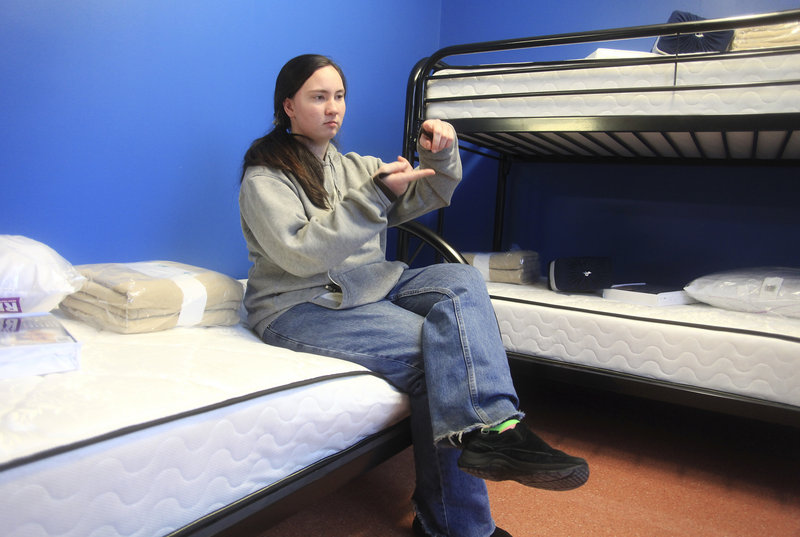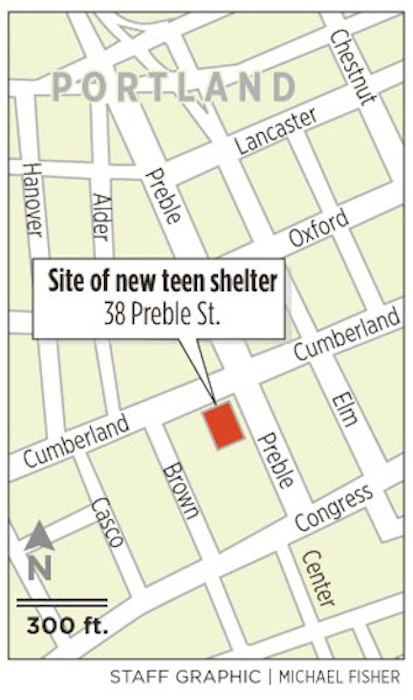PORTLAND – Crystal Swain immediately noticed the new mattresses at Preble Street Resource Center’s Joe Kreisler Teen Shelter.
“These beds are so much better,” the 19-year-old exclaimed as she sat down for an interview Monday.
The $3 million shelter at 38 Preble St. – with its 24 new beds – is set to open in January. Preble Street Resource Center will hold an open house Tuesday from 5:30 to 7:30 p.m. to formally unveil the facility.
It will replace the old, cramped and musty-smelling Lighthouse Teen Shelter on Elm Street. Lighthouse has 16 beds – thin mats on wooden bed frames – and a wooden floor with gaps that make an ideal place for pests to hide.
“You have these little plastic mats that are set on bed frames, yes, but they’re cold and they squish down to nothing. You also have to worry about the bed bugs that can get in there,” said Swain, who still uses the shelter on occasion.
Even with the uncomfortable beds and bed bugs, however, the old shelter is no longer big enough for all the teens and young adults who want to get in.
Homelessness among those between the ages of 12 and 20 increased over the last year, and the 16 beds — eight for boys, eight for girls — at the Lighthouse Shelter fill up fast. Who gets them is determined by a lottery system.
“We’re turning away 18-, 19-, and 20-year-olds every single night now,” said Chris Bicknell, Preble Street’s teen services coordinator.
Starting in January, more teens who are forced onto the streets because of abuse or addiction will have a safe place to stay. The new shelter is named after Preble Street’s founder, who passed away in 2002.
The new Joe Kreisler shelter is twice the size of the old shelter. It has a flexible floor plan with more common space as well as private space for studying and counseling. It combines with the nearby Preble Street Teen Center to provide a safe, full-resource environment for youth 24 hours a day, seven days a week.
Bicknell said most of the teens staying at the shelter are between the ages of 17 and 20. Older kids are forced out of beds and sent to the adult shelter if a younger person is in need of a bed – even if that youngster comes in at 3 a.m.
When a kid shows up at the youth shelter, staff members try to contact a parent or legal guardian within 24 to 72 hours. If that is impossible – or if the child fears for his or her safety – the center contacts the state Department of Health and Human Services.
Teens only stay at the shelter for 30 consecutive days. “Our goal is to return the kids home or find them permanent housing,” Bicknell said.
Swann said the nonprofit Preble Street Resource Center raised $4.5 million in private donations to purchase and renovate the building for the new center. The funds also will cover the $140,000 increase in teen services operating budget over the next 10 years, he said.
While grateful of the private sector’s generosity — including a $20,000 donation from a former teen shelter client — Swann said there has been a lack of public support for the project. “Government needs to play a role in these services and is doing so less and less,” he said.
The new center will be opening at time when demand among teens is up nearly 11 percent for the first 10 months of this year compared to last year.
The biggest year-over-year increase occurred in April, when youths sought shelter 441 times, up 27 percent over the 348 “bed nights” recorded in April, 2011. Numbers jumped again in October, when youths sought shelter 431 times, a 17 percent increase over the previous year. May and July were the busiest months, with young people seeking shelter 453 times each month.
The new shelter is closer to Congress Street and the city’s downtown. In fact, when Preble Street first proposed the new shelter last year, the Portland Downtown District opposed it.
The district, which represents the business community, is still “deeply concerned” about the growing concentration of social services within a two-block radius of Congress Street. However, the group is optimistic Preble Street will be responsive when it comes to concerns of business, said Doug Fuss, president of the PDD’s Board of Directors.
“We feel confident that Mark (Swann) understands the need to be responsible neighbors and to create a safe, clean environment now that he’s in the Downtown District,” Fuss said. “We feel confident they will work with us on these things.”
Bicknell said the center will have twice the staff as the Lighthouse Shelter, which has three staffers during the evening and two overnight.
Swann said businesses should be more concerned about youth who have no shelter and are forced to sleep on the street, under bridges, or engage in illegal activity in exchange for shelter. “I don’t think having kids without anyplace to sleep is good for anybody,” he said.
Swain, the 19-year-old, said teens seeking shelter have to battle not only homelessness and hunger, but also the stigma that they’re a bunch of layabouts, who don’t like their parents and don’t want to do anything all day besides do drugs and drink alcohol.
“It’s completely untrue,” Swain said. “Every single one of the kids I have ever met there is there because they could not be in the place they came from – whether it’s an emotional reason, physical – you name it.”
Swain said she hopes she will never have to use the new center after it opens in January. She has lived off-and-on at Lighthouse over the past two years and said she left home because she didn’t feel safe.
Swain, who recently earned her GED through Portland Adult Education’s Street Academy, is trying to get into college to earn a degree in marine biology and fulfill her dream of having an independent and stable life.
“Hopefully, after (college) I can just be a good citizen in the community and everything else,” she said.
Staff Writer Randy Billings can be contacted at 791-6346 or at:
rbillings@mainetoday.com
Twitter: @randybillings
Send questions/comments to the editors.






Comments are no longer available on this story